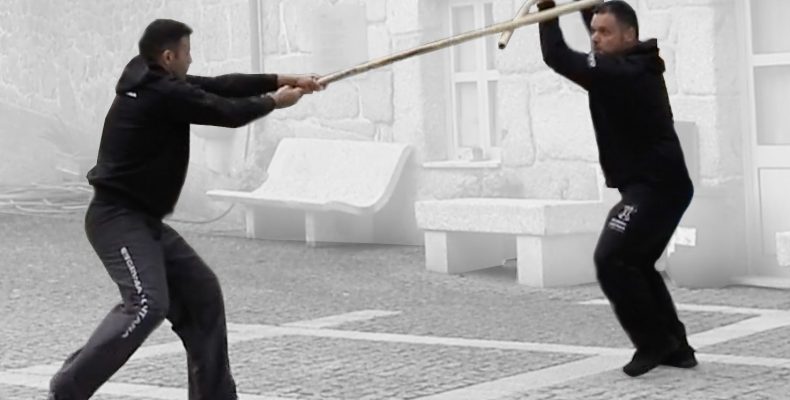The “Jogo do Pau Português” is a martial art of Portuguese origin that consists on the technique of handling a stick or staff with the purpose of self-defense.
It is also a Portuguese national cultural and historical heritage, which despite having an unknown origin or author, has survived and is preserved until today, in popular tradition.
This technique was traditionally used by the lower classes since the most remote times, there are no technical manuals prior to the 19th century, however, some parallels with medieval fighting techniques and tactics are recognized in the technique, especially with the heavier weapons such as the one and a half-handed sword (espada bastarda) or the Montante.
It is impossible to say whether the people copied this technique of the nobles, or if it was the other way around, but by the chronicles and techniques we know today we can assume with some confidence that these techniques coexisted in time and space. Who knows if the famous Portuguese medieval fighters that conquered so much with so little numbers might have benefited from our staff fighting technique.
More recently, at the end of the 19th century and the beginning of the 20th century, staff battles at fairs and pilgrimages that sometimes involved entire villages were still frequent throughout the country. In Lisbon, a style of sporting characteristics was developed at the beginning of the 20th century, practiced in clubs such as Real Ginásio Clube, later Ginásio Clube Português, Lisboa Ginásio Clube and Ateneu Comercial de Lisboa, but as far as we know, it has left some films and documentaries but no one is actually practicing it anymore.
Currently, this Portuguese fencing, has several clubs left from the south to the north of Portugal, practicing several techniques of Jogo do Pau, among witch is the Jogo do Pau Cascais School, that in addition to its martial and self-defense characteristics (in its most practical form – the baton), is also developing the martial art into a form of competitive sport, in which synthetic material is used in order to preserve integrity of the players.
The possibility to fight in a competitive environment allows the athletes to test there skills and technique in a 1 to 1 or 1 to multiple opponents with some rules and protections, a closer and safer approximation to the traditional duels, complementing the traditional training, and acting as a promotional engine for the newest generations.
The Jogo do Pau de Cascais group’s mission is to develop the study, practice, dissemination and dignification of Jogo do Pau as traditional Portuguese art, as well as to preserve a national cultural heritage, whose value is internationally recognized.
You can see this article in the original portuguese version in this link
Written by: Ricardo Moura (Jogo do Pau Cascais – Stafffighters)
